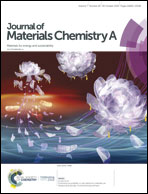Streptavidin activated hydroxyl radicals enhanced photocatalytic and photoelectrochemical properties of membrane-bound like CaMoO4:Eu3+ hybrid structures†
Abstract
Recently, organic–inorganic hybrid structures have gained significant interest and are considered as an innovative alternative for the development of multifunctional materials. Herein, we report highly reliable and reproducible protein–inorganic hybrid CaMoO4:Eu3+ microstructures as a novel photocatalyst for decontamination of environments using an energy-efficient and cost-effective green synthesis. In this synthesis process, streptavidin (SA) serves as an organic scaffold and builds covalent bonds with the amine groups of the CaMoO4:Eu3+ surface, which leads to the formation of membrane-bound-like structures. Because of the well overlapped absorption bands of tyrosine residues and CaMoO4:Eu3+, SA acts as a sensitizer and transfers more UV energy to the MoO4 moieties of CaMoO4:Eu3+, resulting in an enhanced emission intensity along with a blue shifted absorption spectrum. Compared to the commercial TiO2, the CaMoO4:Eu3+ host and SA modified CaMoO4:Eu3+ microstructures exhibit 145 and 207% higher dye removal efficiencies for methylene blue, signifying their light absorption efficiency and higher number of surface-active sites. After hybridization with SA, the CaMoO4:Eu3+ sample offers more photo-generated electrons to improve the photocatalytic activity along with an enhanced photocurrent density of 0.72 μA cm−2, which is about 1.5 times higher than that of the CaMoO4:Eu3+ host. Moreover, the SA modified CaMoO4:Eu3+ sample displayed excellent photocatalytic stability after 6 reusability cycles. Our synthesis strategy for protein–inorganic hybrid CaMoO4:Eu3+ opens a new avenue for the production of cutting-edge materials for industrial-scale catalysis and solid-state lighting applications.



 Please wait while we load your content...
Please wait while we load your content...